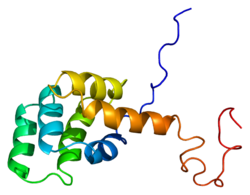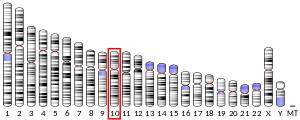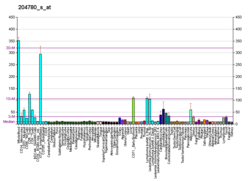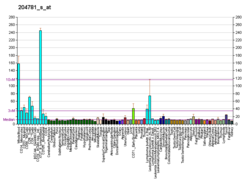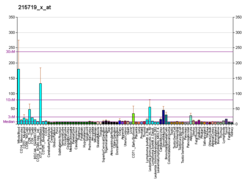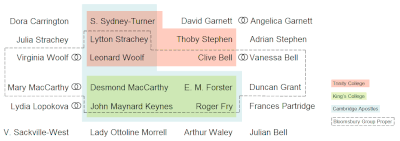Fas 수용체
Fas receptorFas, FasR, 아포토시스 항원 1(APO-1 또는 APT), 분화 95(CD95) 클러스터 또는 종양 괴사인자 수용체 슈퍼패밀리 멤버 6(TNFRSF6)이라고도 하는 Fas 수용체는 인간에서 [5][6]FAS 유전자에 의해 암호화되는 단백질이다.Fas는 FS-7 세포주로 생쥐를 면역화함으로써 생성된 모노클로널 항체를 사용하여 처음 확인되었다.따라서 Fas라는 이름은 FS-7 관련 표면 [7]항원에서 유래하였다.
Fas 수용체는 세포 표면에 있는 사망 수용체로 배위자 Fas 리간드(FasL)와 결합할 경우 프로그램된 세포사망(apotosis)으로 이어진다.그것은 두 개의 아포토시스 경로 중 하나이며, 다른 하나는 미토콘드리아 [8]경로이다.
진
FAS 수용체 유전자는 사람의 경우 10번 염색체(10q24.1)의 긴 팔과 생쥐의 경우 19번 염색체에 위치한다.이 유전자는 플러스(왓슨 스트랜드)에 있으며 엑손(exon)을 코드하는 9개의 단백질로 구성된 길이 25,255개의 염기이다.진화와 관련된 유사한 배열은 대부분의 포유류에서 [9]발견됩니다.
단백질
이전 보고서에서는 무려 8개의 스플라이스 변형이 확인되었으며, 이는 단백질의 7가지 동질체로 번역됩니다.아포토시스 유도 Fas 수용체는 isoform 1로 불리며 1종 트랜스막 단백질이다.다른 많은 동종 형태들은 희귀 하플로타입으로 보통 질병 상태와 관련이 있다.단, 아포토시스 유도막 결합형 및 가용성형 두 가지 아이소폼은 세포독성 RNA 결합단백질 TIA1에 [10]의해 대체 스플라이싱을 통한 생산이 조절되는 정상제품이다.
성숙한 Fas 단백질은 아미노산이 319개, 분자량이 48킬로Daltons로 예측되며 세포외 도메인, 막간 도메인, 세포질 도메인 등 3개의 도메인으로 구분된다.세포외 도메인은 157개의 아미노산을 가지고 있으며 시스테인 잔기가 풍부하다.트랜스막 도메인과 세포질 도메인은 각각 17, 145개의 아미노산을 가지고 있다.엑손 1~5는 세포외 영역을 부호화한다.Exon6은 막간 통과 영역을 부호화한다.엑손 7-9는 세포내 영역을 부호화한다.
기능.
Fas는 배위자 결합 시 사망 유도 신호 복합체(DISC)를 형성합니다.인접한 세포 표면의 막 고정 Fas 리간드 삼량체는 Fas의 올리고머화를 일으킨다.FAS의 트리머라이제이션에 대한 최근의 연구는 검증되지 않았습니다.다른 모델에서는 [11]DISC에서 최대 5-7개의 Fas 분자를 올리고머화하는 방법을 제안했습니다.일부 증거는 항체에 의해 유도되는 아포토시스 신호가 Fas 시그널링 연구에서 신뢰할 수 없다는 것을 시사하지만, 이러한 현상은 작용제 Fas 항체의 결합에 의해 모방된다.이를 위해 시험관내 연구를 위해 항체를 삼량화하는 몇 가지 현명한 방법이 사용되었습니다.
후속 사망 도메인(DD) 집계에 따라 수용체 복합체는 세포 내염기계를 통해 내부화된다.이를 통해 어댑터 분자 FADD는 자체 데스 [12]도메인을 통해 Fas의 데스 도메인을 결합할 수 있습니다.
FADD는 또한 아미노 [13]말단 근처에 데스 이펙터 도메인(DED)을 포함하고 있으며, 이는 더 일반적으로 카스파아제-8로 언급되는 FADD 유사 인터류킨-1 베타 변환 효소(FLICE)의 DED와의 결합을 촉진한다.그런 다음 FLICE는 단백질 분해 과정을 통해 활성 헤테로테트라머 효소를 형성하는 p10 및 p18 서브유닛으로 자가 활성화될 수 있다.활성 카스파아제-8은 다음으로 DISC에서 세포질로 방출되어 다른 이펙터 카스파아제를 분해하고, 최종적으로 DNA 분해, 막 블리딩 및 아포토시스의 다른 특징을 일으킨다.
최근 Fas는 종양 진행 중에 종종 하향 조절되거나 세포에 내자멸성이 생기기 때문에 종양 성장을 촉진하는 것으로 나타났다.일반적으로 Fas 아포토시스 민감도에 관계없이 암세포는 Fas의 구성 활성에 따라 달라집니다.이는 암이 생성하는 Fas 배위자에 의해 자극되어 최적의 [14]성장을 실현합니다.
비록 파스 위의 마우스 모델에서 종양 성장을 촉진하는 것으로 나타났다, 인간의 암 유전체학 데이터베이스의 분석은 가지게 초점에. 3131 종양의 데이터를 가로질러( 가진 종양 유전자지 않다)이 초점에. 이 3131의 전체 데이터 집합이 가지는 tumors,[15]을 가로질러 삭제됩니다를 상세히 설명했다 아니다고 밝혔다. func인간의 종양 억제제 역할을 합니다
배양 세포에서 FasL은 Fas 수용체를 통해 다양한 유형의 암세포 아포토시스를 유도한다.AOM-DSS 유도 대장암 및 MCA 유도 육종 마우스 모델에서는 Fas가 종양 억제제 [16]역할을 하는 것으로 나타났다.또한 Fas 수용체는 종양 특이 세포 독성 T림프구(CTL) 항종양 세포 독성도 [17]매개한다.잘 기술된 표적 CTL 항종양 세포독성 외에도 Fas는 독특한 기능, 즉 동질 항원 비발현(방관자) 세포 간에도 방관자 종양 세포 사멸을 유도하는 기능을 가지고 있는 것으로 알려져 있다.CTL 매개 방관자 살인은 1986년[18] 플라이셔 연구소에 의해 기술되었으며, 나중에 오스틴 연구소의 세포독성 [19]연구소에 의해 체외에서 fas 매개 용해에 기인했다.보다 최근에는 암겐에서 [21]수행된 이원 특이 항체를 사용한 추가 시험관내 작업과 유사한 T 세포와 CAR-T [20]세포를 사용한 Mount Synai 의과대학 림프종 면역치료 프로그램에 의해 근막 매개 방관자 종양 세포 사멸이 생체 내에서 입증되었다.
아포토시스에서의 역할
일부 보고서는 외인성 Fas 경로가 DISC 조립 및 후속 카스파아제-8 활성화를 통해 특정 세포 유형에서 완전한 아포토시스를 유도하기에 충분하다고 제안했다.이러한 세포는 Type 1 세포라고 불리며, Bcl-2 패밀리(Bcl-2 및 Bcl-xL)의 항아포토시스 구성원은 Fas 매개 아포토시스로부터 보호할 수 없는 것이 특징이다.특징적인 제1형 세포는 H9, CH1, SKW6.4, SW480이며, 림프구 계통인 대장선암 계통을 제외한 모든 세포는 림프구 계통이다.그러나 Fas 신호 캐스케이드에는 외적 경로와 내적 경로 간의 크로스톡에 대한 증거가 있습니다.
대부분의 세포 유형에서 카스파아제-8은 프로아포토시스 BH3 전용 단백질 Bid를 잘린 형태인 tBid로 분해하는 것을 촉매한다.BH-3은 Bcl-2 패밀리의 항아포토시스 멤버(Bcl-2, Bcl-xL)만을 배타적으로 관여시켜 Bak 및 Bax가 미토콘드리아 외막으로 전이되도록 함으로써 이를 침투시키고 길항제인 시토크롬c 및 Smac/optic AP블로와 같은 프로아포토시스 단백질의 방출을 촉진한다.PS)
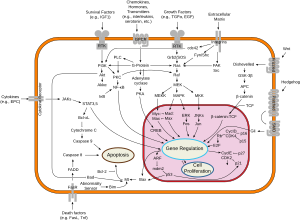
상호 작용
Fas 수용체는 다음 제품과 상호 작용하는 것으로 나타났습니다.
- Caspase 8,[22][23][24]
- 케이스 10,[25]
- CFLAR,[23][24]
- FADD,[22][23][26][27][28][29]
- FAS 리간드,[22][30][31][32]
- PDCD6 [33]및
- 작은 유비퀴틴 관련 수식어 1.[34][35]
레퍼런스
- ^ a b c GRCh38: 앙상블 릴리즈 89: ENSG000026103 - 앙상블, 2017년 5월
- ^ a b c GRCm38: 앙상블 릴리즈 89: ENSMUSG000024778 - 앙상블, 2017년 5월
- ^ "Human PubMed Reference:". National Center for Biotechnology Information, U.S. National Library of Medicine.
- ^ "Mouse PubMed Reference:". National Center for Biotechnology Information, U.S. National Library of Medicine.
- ^ Lichter P, Walczak H, Weitz S, Behrmann I, Krammer PH (September 1992). "The human APO-1 (APT) antigen maps to 10q23, a region that is syntenic with mouse chromosome 19". Genomics. 14 (1): 179–80. doi:10.1016/S0888-7543(05)80302-7. PMID 1385299.
- ^ Inazawa J, Itoh N, Abe T, Nagata S (November 1992). "Assignment of the human Fas antigen gene (Fas) to 10q24.1". Genomics. 14 (3): 821–2. doi:10.1016/S0888-7543(05)80200-9. PMID 1385309.
- ^ Nagata S (July 2004). "Early work on the function of CD95, an interview with Shige Nagata". Cell Death and Differentiation. 11 Suppl 1 (Suppl 1): S23-7. doi:10.1038/sj.cdd.4401453. PMID 15143352.
- ^ Wajant H (May 2002). "The Fas signaling pathway: more than a paradigm". Science. 296 (5573): 1635–6. Bibcode:2002Sci...296.1635W. doi:10.1126/science.1071553. PMID 12040174. S2CID 29449108.
- ^ "OrthoMaM phylogenetic marker: FAS coding sequence". Archived from the original on 2016-03-03. Retrieved 2009-12-02.
- ^ Izquierdo JM, Majós N, Bonnal S, Martínez C, Castelo R, Guigó R, et al. (August 2005). "Regulation of Fas alternative splicing by antagonistic effects of TIA-1 and PTB on exon definition". Molecular Cell. 19 (4): 475–84. doi:10.1016/j.molcel.2005.06.015. PMID 16109372.
- ^ Wang L, Yang JK, Kabaleeswaran V, Rice AJ, Cruz AC, Park AY, et al. (November 2010). "The Fas-FADD death domain complex structure reveals the basis of DISC assembly and disease mutations". Nature Structural & Molecular Biology. 17 (11): 1324–9. doi:10.1038/nsmb.1920. PMC 2988912. PMID 20935634.
- ^ Huang B, Eberstadt M, Olejniczak ET, Meadows RP, Fesik SW (1996). "NMR structure and mutagenesis of the Fas (APO-1/CD95) death domain". Nature. 384 (6610): 638–41. Bibcode:1996Natur.384..638H. doi:10.1038/384638a0. PMID 8967952. S2CID 2492303.
- ^ Eberstadt M, Huang B, Chen Z, Meadows RP, Ng SC, Zheng L, et al. (April 1998). "NMR structure and mutagenesis of the FADD (Mort1) death-effector domain". Nature. 392 (6679): 941–5. Bibcode:1998Natur.392..941E. doi:10.1038/31972. PMID 9582077. S2CID 4370202.
- ^ Chen L, Park SM, Tumanov AV, Hau A, Sawada K, Feig C, et al. (May 2010). "CD95 promotes tumour growth". Nature. 465 (7297): 492–6. Bibcode:2010Natur.465..492C. doi:10.1038/nature09075. PMC 2879093. PMID 20505730.
- ^ "Tumorscape". The Broad Institute. Archived from the original on 2012-04-14. Retrieved 2012-07-05.
- ^ Liu F, Bardhan K, Yang D, Thangaraju M, Ganapathy V, Waller JL, et al. (July 2012). "NF-κB directly regulates Fas transcription to modulate Fas-mediated apoptosis and tumor suppression". The Journal of Biological Chemistry. 287 (30): 25530–40. doi:10.1074/jbc.M112.356279. PMC 3408167. PMID 22669972.
- ^ Yang D, Torres CM, Bardhan K, Zimmerman M, McGaha TL, Liu K (May 2012). "Decitabine and vorinostat cooperate to sensitize colon carcinoma cells to Fas ligand-induced apoptosis in vitro and tumor suppression in vivo". Journal of Immunology. 188 (9): 4441–9. doi:10.4049/jimmunol.1103035. PMC 3398838. PMID 22461695.
- ^ Fleischer B (August 1986). "Lysis of bystander target cells after triggering of human cytotoxic T lymphocytes". European Journal of Immunology. 16 (8): 1021–4. doi:10.1002/eji.1830160826. PMID 3488908. S2CID 27562316.
- ^ Smyth MJ, Krasovskis E, Johnstone RW (July 1998). "Fas ligand-mediated lysis of self bystander targets by human papillomavirus-specific CD8+ cytotoxic T lymphocytes". Journal of Virology. 72 (7): 5948–54. doi:10.1128/JVI.72.7.5948-5954.1998. PMC 110399. PMID 9621057.
- ^ Upadhyay R, Boiarsky JA, Pantsulaia G, Svensson-Arvelund J, Lin MJ, Wroblewska A, et al. (December 2020). "A critical role for fas-mediated off-target tumor killing in T cell immunotherapy". Cancer Discovery. 11 (3): 599–613. doi:10.1158/2159-8290.CD-20-0756. ISSN 2159-8274. PMC 7933082. PMID 33334730.
- ^ Ross SL, Sherman M, McElroy PL, Lofgren JA, Moody G, Baeuerle PA, et al. (2017-08-24). "Bispecific T cell engager (BiTE®) antibody constructs can mediate bystander tumor cell killing". PLOS ONE. 12 (8): e0183390. Bibcode:2017PLoSO..1283390R. doi:10.1371/journal.pone.0183390. PMC 5570333. PMID 28837681.
- ^ a b c Gajate C, Mollinedo F (March 2005). "Cytoskeleton-mediated death receptor and ligand concentration in lipid rafts forms apoptosis-promoting clusters in cancer chemotherapy". The Journal of Biological Chemistry. 280 (12): 11641–7. doi:10.1074/jbc.M411781200. PMID 15659383.
- ^ a b c MacFarlane M, Ahmad M, Srinivasula SM, Fernandes-Alnemri T, Cohen GM, Alnemri ES (October 1997). "Identification and molecular cloning of two novel receptors for the cytotoxic ligand TRAIL". The Journal of Biological Chemistry. 272 (41): 25417–20. doi:10.1074/jbc.272.41.25417. PMID 9325248.
- ^ a b Shu HB, Halpin DR, Goeddel DV (June 1997). "Casper is a FADD- and caspase-related inducer of apoptosis". Immunity. 6 (6): 751–63. doi:10.1016/S1074-7613(00)80450-1. PMID 9208847.
- ^ Vincenz C, Dixit VM (March 1997). "Fas-associated death domain protein interleukin-1beta-converting enzyme 2 (FLICE2), an ICE/Ced-3 homologue, is proximally involved in CD95- and p55-mediated death signaling". The Journal of Biological Chemistry. 272 (10): 6578–83. doi:10.1074/jbc.272.10.6578. PMID 9045686.
- ^ Pan G, O'Rourke K, Chinnaiyan AM, Gentz R, Ebner R, Ni J, Dixit VM (April 1997). "The receptor for the cytotoxic ligand TRAIL". Science. 276 (5309): 111–3. doi:10.1126/science.276.5309.111. PMID 9082980. S2CID 19984057.
- ^ Huang B, Eberstadt M, Olejniczak ET, Meadows RP, Fesik SW (1996). "NMR structure and mutagenesis of the Fas (APO-1/CD95) death domain". Nature. 384 (6610): 638–41. Bibcode:1996Natur.384..638H. doi:10.1038/384638a0. PMID 8967952. S2CID 2492303.
- ^ Chinnaiyan AM, O'Rourke K, Tewari M, Dixit VM (May 1995). "FADD, a novel death domain-containing protein, interacts with the death domain of Fas and initiates apoptosis". Cell. 81 (4): 505–12. doi:10.1016/0092-8674(95)90071-3. PMID 7538907. S2CID 16906755.
- ^ Thomas LR, Stillman DJ, Thorburn A (September 2002). "Regulation of Fas-associated death domain interactions by the death effector domain identified by a modified reverse two-hybrid screen". The Journal of Biological Chemistry. 277 (37): 34343–8. doi:10.1074/jbc.M204169200. PMID 12107169.
- ^ Micheau O, Tschopp J (July 2003). "Induction of TNF receptor I-mediated apoptosis via two sequential signaling complexes" (PDF). Cell. 114 (2): 181–90. doi:10.1016/S0092-8674(03)00521-X. PMID 12887920. S2CID 17145731.
- ^ Starling GC, Bajorath J, Emswiler J, Ledbetter JA, Aruffo A, Kiener PA (April 1997). "Identification of amino acid residues important for ligand binding to Fas". The Journal of Experimental Medicine. 185 (8): 1487–92. doi:10.1084/jem.185.8.1487. PMC 2196280. PMID 9126929.
- ^ Schneider P, Bodmer JL, Holler N, Mattmann C, Scuderi P, Terskikh A, et al. (July 1997). "Characterization of Fas (Apo-1, CD95)-Fas ligand interaction". The Journal of Biological Chemistry. 272 (30): 18827–33. doi:10.1074/jbc.272.30.18827. PMID 9228058.
- ^ Jung YS, Kim KS, Kim KD, Lim JS, Kim JW, Kim E (October 2001). "Apoptosis-linked gene 2 binds to the death domain of Fas and dissociates from Fas during Fas-mediated apoptosis in Jurkat cells". Biochemical and Biophysical Research Communications. 288 (2): 420–6. doi:10.1006/bbrc.2001.5769. PMID 11606059.
- ^ Okura T, Gong L, Kamitani T, Wada T, Okura I, Wei CF, et al. (November 1996). "Protection against Fas/APO-1- and tumor necrosis factor-mediated cell death by a novel protein, sentrin". Journal of Immunology. 157 (10): 4277–81. PMID 8906799.
- ^ Ryu SW, Chae SK, Kim E (December 2000). "Interaction of Daxx, a Fas binding protein, with sentrin and Ubc9". Biochemical and Biophysical Research Communications. 279 (1): 6–10. doi:10.1006/bbrc.2000.3882. PMID 11112409.
추가 정보
- Nagata S (February 1997). "Apoptosis by death factor". Cell. 88 (3): 355–65. doi:10.1016/S0092-8674(00)81874-7. PMID 9039262. S2CID 494841.
- Cascino I, Papoff G, Eramo A, Ruberti G (January 1996). "Soluble Fas/Apo-1 splicing variants and apoptosis". Frontiers in Bioscience. 1 (4): d12-8. doi:10.2741/A112. PMID 9159204.
- Uckun FM (September 1998). "Bruton's tyrosine kinase (BTK) as a dual-function regulator of apoptosis". Biochemical Pharmacology. 56 (6): 683–91. doi:10.1016/S0006-2952(98)00122-1. PMID 9751072.
- Krammer PH (October 2000). "CD95's deadly mission in the immune system". Nature. 407 (6805): 789–95. Bibcode:2000Natur.407..789K. doi:10.1038/35037728. PMID 11048730. S2CID 4328897.
- Siegel RM, Chan FK, Chun HJ, Lenardo MJ (December 2000). "The multifaceted role of Fas signaling in immune cell homeostasis and autoimmunity". Nature Immunology. 1 (6): 469–74. doi:10.1038/82712. PMID 11101867. S2CID 345769.
- Yonehara S (2003). "Death receptor Fas and autoimmune disease: from the original generation to therapeutic application of agonistic anti-Fas monoclonal antibody". Cytokine & Growth Factor Reviews. 13 (4–5): 393–402. doi:10.1016/S1359-6101(02)00024-2. PMID 12220552.
- Choi C, Benveniste EN (January 2004). "Fas ligand/Fas system in the brain: regulator of immune and apoptotic responses". Brain Research. Brain Research Reviews. 44 (1): 65–81. doi:10.1016/j.brainresrev.2003.08.007. PMID 14739003. S2CID 46587211.
- Poppema S, Maggio E, van den Berg A (March 2004). "Development of lymphoma in Autoimmune Lymphoproliferative Syndrome (ALPS) and its relationship to Fas gene mutations". Leukemia & Lymphoma. 45 (3): 423–31. doi:10.1080/10428190310001593166. PMID 15160902. S2CID 35128360.
